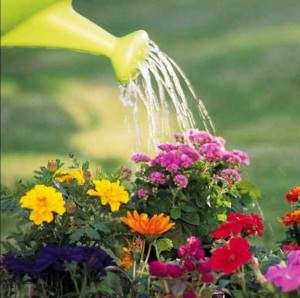Water Well
Categories: News
Care of our plants becomes more important when changes in plant growth take place at an accelerated rate such as in spring and summer. The metabolic rate of plants speeds up when it becomes warm. The demand for proper watering of planters and hanging baskets takes place rather quickly and becomes much more critical. The same thing happens to the plants in our landscape but at a much slower pace. The changes are more gradual but they are still happening.
Proper watering practices seem to be one of the most difficult skills for a lot of people to acquire and understand. It boils down to being consistent in our care of the plants we have to enjoy. Providing moisture at the right time is very important. Plants need water to keep nutrients moving through the vascular system from roots to the tips of the leaves and blossoms. Plants also require oxygen at the root zone. Balancing these needs is the tricky part.
When soils contain too little water, moisture moves out of the plant cells and the cells will become flaccid. This lack of water causes the plants to stop being able to support themselves. Leaves and stems become soft and wilt. When soils are saturated with too much water for an extended period of time, oxygen is not present in the soil. The plant will begin to suffer and wilt. It may even develop the same look as a plant that is too dry. With the correct amount of water, the process continues effectively and keeps the plant healthy and vibrant.
One way to determine if a plant in a pot or hanging basket needs watered is to lift the container to see how heavy it is. Another way to see if water is needed is to use the “first knuckle” test. Take your index finger and push it into the soil around the plant you’re getting ready to water. If the soil is moist, do not water. If, on the other hand, the soil feels dry and no soil sticks to your finger then it is time to water. Moisture meters are available for this purpose but the knuckle test works pretty well.
Just remember, you can kill a plant with kindness.
- Water well when you do water. Most plants need an inch of water a week.
- Wait until the plant dries down before watering again.
- Avoid extreme “dry downs”. When the soil shrinks away from the sides of the container the plant is much too dry. Many times the plant cannot be revived from such treatment.
By watching your plants and testing their soil, you will gain a better understanding of the watering needs for your plant’s variety and specific location. Just remember, if you move a plant, you may have to adjust its watering frequency. With a little time and patience, you can become a watering pro!
MVG - Growing Sustainably Since 1984







Comments are closed.